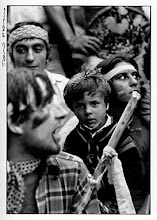Claudia Salaris, Il movimento del Settantasette. Linguaggi e scritture dell'ala creativa

“Grazie a noi il tempo verra in cui la vita non sara piu
semplicamente una vita di pane e di fatica, ne una vita d'ozio
ma in cui la vita sara vita-opere d'arte”
Marinetti in “Al di la del communismo.”
“Trascinato sulla strada
fra due barricate
si trova stupito
a sounar note
piu calde, piu dolci
Il mogano lucido
circondato dal fumo
sporco del lacrimogeni.”
“Chopin sulle Barricate”, Lotta Continua, 14th July,1977.
The first quote is from Italian Futurist Filippo Tommaso Marinetti, affirming, along with the other movements of the early 20th century avante-garde, Futurisms desire to transform the existing social relationships of their day by superseding the division between everyday life and art. The second appeared in the new left newspaper “Lotta Continua” and is from a poem describing the surreal atmosphere of the university occupation in Bologna in 1977 where tear gas and smoke filled the air and students played piano near the barricades and drank champagne they “liberated” from a nearby restaurant.
Both are from a book called “Il movimento del Settantasette. Linguaggi e scritture dell'ala creativa” by art historian Claudia Salaris. Published in 1997 for the 20th anniversary of “settantasette”, it looks at the writings and zines of the creative wing of Autonomia (journalists from the time often used “Indianismo” to describe the creatives, of course named after the Indiani Metropolitani.)
Salaris is an historian of Italian Futurism of the early 20th century and sees much of the writing and politics through the prism of Futurisms utopian, ludic and anti-authoritarian elements, as opposed to its infamous militarist and nationalist positions. Likewise, she notes the antecedents of other utopian aesthetics such as Dadaism, Surrealism and Situationism: all seeking to overturn the social relationships of capital with those creativity and collective experimentation and all hostile to forms of mediation (political, ideological or otherwise.)
Its an interesting perspective as most writings on Autonomia (especially in English) are more interested in issues of class composition and the emergent political forms related to it; the forms of praxis and intellectual orientation of “il movimento” are traced and explained by its links to the Autonomist Marxism and to American influenced counter-cultural politics rather than to earlier artistic movements.


0 Comments:
Post a Comment
Subscribe to Post Comments [Atom]
<< Home